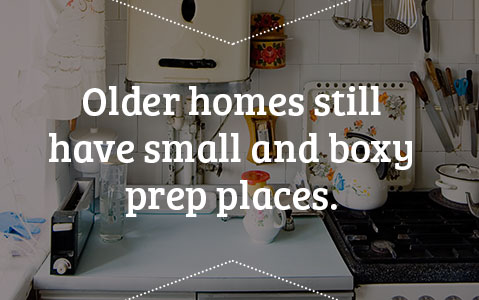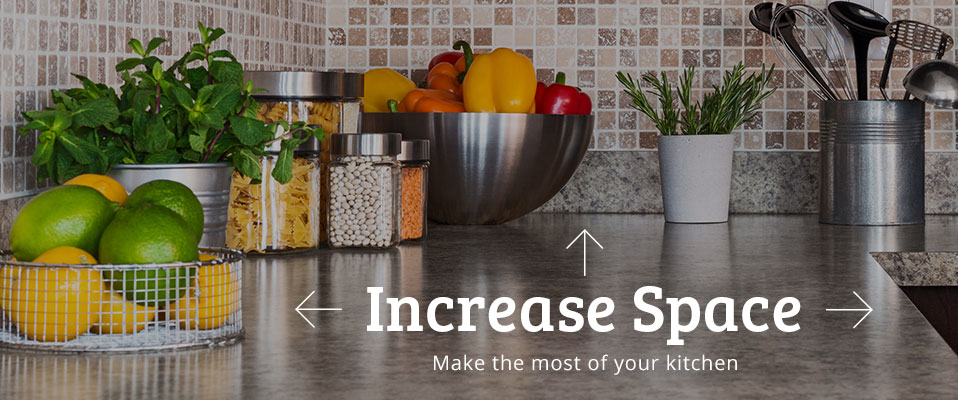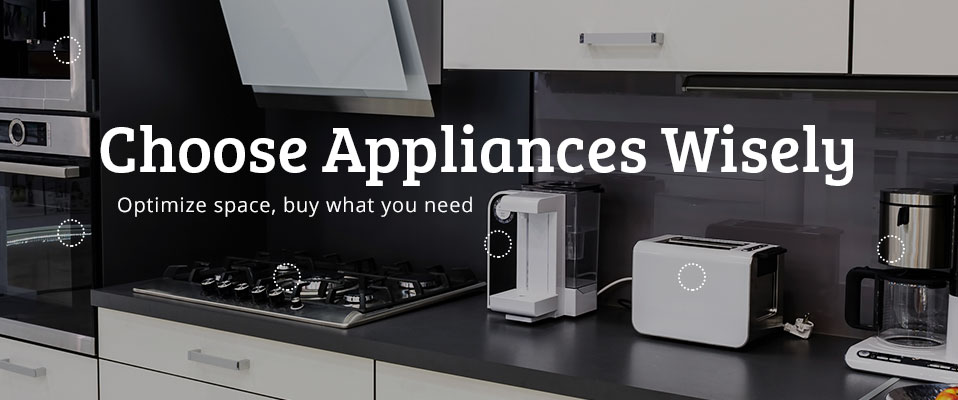
Living in a home with small kitchen can be a blessing or a curse, depending on how you look at it. Although cooking in a small kitchen can make it difficult to spread out and use your preferred equipment for crafting your meals, it also provides you with less space that needs to be cleaned. Working in a smaller area will also force you to make the most of the space you have available — and you can still create delicious meals that impress your family and friends.
Take a look at these tips to make the most of your small kitchen space. Your guests will think they are dining in a 5-star restaurant — and you’ll be the only one who knows of the space limitations you were dealing with.
How to Make the Most of a Small Kitchen
 Small kitchens are standard in most rental units since landlords don’t want to put the time or money into expanding the space for someone who will likely only be living there for a short time. Urban areas, like New York City and Los Angeles, are also notorious for small kitchens because space is a premium there, as well as in other overcrowded cities.
Small kitchens are standard in most rental units since landlords don’t want to put the time or money into expanding the space for someone who will likely only be living there for a short time. Urban areas, like New York City and Los Angeles, are also notorious for small kitchens because space is a premium there, as well as in other overcrowded cities.
However, even if you buy a home in the suburbs, you might still be faced with a small kitchen if the house was built before the 2000s. Large kitchens only became popular in the past few decades, and while newer homes often have plenty of counter space and even middle-of-the-kitchen islands, older homes still have small and boxy prep places. Here are some ways you can work around that.

When dealing with a kitchen that is what a real estate agent would call “quaint,” you want to make the most of it without spending a lot of money. By arranging and designing things carefully, you can visually expand the space. Consider the following:
1. Organize accordingly. Stand in front of your stove and consider which kitchen tools you use the most for your small kitchen cooking. Store your most used gadgets and ingredients closest to the oven. Things you don’t use very often can be placed farther away or even in a different location so they don’t take up valuable space.
Do the same with your dish washer. Since most large items like pots and pans will be washed by hand in the sink, you’ll want to store them closer to your stove, and your dishes and glasses can be closer to the dish washer so it’s easier to put them all away.
2. Create your own space. With a little creativity, and maybe some do-it-yourself projects, you can create more space in a few simple steps. First, check if your cutting board fits over your sink. If it does, you can do your chopping right there instead of taking up more counter space. If your sink is an odd size or if your cutting board is too small, measure the width of the sink and buy a piece of plywood about 3-4 inches wider than your sink’s edges.
It’s important to note that unless the wood is treated with a food-safe finish, you shouldn’t use this in direct contact with your ingredients. You can place the plywood over the sink, though, and use the extra space for mixing bowls or as a space to line up your kitchen tools before you start cooking. If you want to go a step further, you can sand the plywood and cover it with food-safe contact paper in a color or pattern that coordinates with your kitchen. Burner covers work the same way by freeing up some of the space that’s taken over by your stove top.
3. Build up, not out. Unless your cabinets extend to the ceiling, many kitchens have an abundance of unused space up there. Bulky items that take up a lot of real estate, like tall pots, electric griddles and crock pots, can easily be tucked up above your cabinets. Just make sure not to store items that are too small or you might lose track of them since it can be difficult to inspect what’s up there. An easy solution is to use a large bowl to hold loose items, like corn cob holders and napkins rings, then put the bowl on top of the cabinet. You can also use your counter space in a vertical manner by utilizing stackable cooling racks to hold plates, bakeware and cutting boards.
4. Look for small, unused space. Most kitchens have a space of about two inches between the refrigerator and the adjoining countertop. Although it’s not very wide, it’s usually at least 18 inches deep, so it’s a good place to store cutting boards, serving trays and flat pizza pans. A takeout or home delivery pizza box should fit comfortably in this area, so you could dust out a box, reinforce the corners and place seldom-used flatware or other flat kitchen utensils inside, and then slip the box next to the refrigerator. You might also be able to use magnets or suction cups on the side of the refrigerator to mount spatulas, knives and spoons.
5. Move your space-takers. Most kitchen counters house several items that are basically permanent fixtures. Coffee makers, toaster ovens, sugar bowls and knife blocks can be found in almost every kitchen, but if you don’t use them daily, they can be put elsewhere.
While coffee makers used to be an essential appliance for breakfast, many people now drink coffee at the office or pick up a cup during their commute to work. If this is you, you can probably move your coffee maker to the top of your cabinets or to the bottom of your pantry. The same goes for your toaster oven. It can be handy for heating up frozen foods, but it really eats away at your space — especially if it’s not used regularly.
As for knife blocks, you can do away with them permanently by anchoring a magnetic knife strip on your backsplash or a wall. Your knives will hang on the strip, making them easy to access without wasting your valuable space.
6. Hang it up. Wire hanging baskets can free up counter space otherwise used for fresh fruit and light items, like baked goods. These basics are inexpensive and can easily be installed in most kitchens without leaving behind damaging marks that might be frowned upon in rental units. Additionally, decorative hooks can be mounted onto the walls of your kitchen to hang coffee mugs and pot holders.
Though considered unsightly by some, ceiling-mounted pot racks free up a ton of space that gets wasted by simply storing bulky items, some of which aren’t even used that often. In each of these situations, you’ll need to consider how easily it is to install and how you’ll remove it when you leave the property. If you didn’t spend a lot of money on the hooks or racks, it might be easier to just leave them behind when you move out. Chances are, the next resident will be happy to make use of the hanging storage system when they take over the kitchen.
7. Invest in a roll-away island. Also known as metro tables, these foldable, stainless steel-topped islands provide you with additional counter space along with an area to store your extra appliances and bulky serving platters. But, if you don’t have enough storage where you can tuck this away when it’s not in use, it might not be a good investment if it’s just one more thing that gets in your way.
8. Elevate with a tension rod. A simple, inexpensive tension rod — like the kind you use to hold up a shower curtain — is another great way to hang items that would normally suck up space in your drawers and cabinets. Mount one in your pantry or at the top of a cabinet and attach several “s” hooks to it. You’ll be able to hang ladles, tongs, pot holders and even pots and pans. Just make sure not to put too many heavy items on it since many tension rods can only hold a few pounds.
9. Use the inside of your cabinet doors. Simple suction-cup mounted wire or plastic racks can be used to hold spices, mixing spoons and spatulas. If you have enough space and a deep enough rack, you could also keep plastic lids and pan lids here to eliminate the clutter they usually cause in drawers and cupboards.
10. Stuff your oven. Pots and pans (and their lids) can easily be stored in your oven until you need them. The only drawback to this is that you have to empty the entire oven to use it and will need to find a new space to keep them or stack them up on a counter or unused table. But, if you’re not using several of the pots and pans, there’s no reason not to push them under your bed or even temporarily store them in an unused bathtub for the few hours that the oven is being used.
11. Think about what you can eliminate. Even if things can’t be eliminated entirely, they might be able to be moved to storage. For instance, if you live with just one other person, you probably don’t need a whole bunch of dishes in your cabinets. Not only do they take up a lot of space, but they also create more dishes to clean since you’ll likely use all of them. You can probably put half of that dinnerware into a box under your bed or put it up in the attic.
You might want to quickly access those dishes when you are entertaining, but unless that happens a few times a week, you can likely get away with putting most of it aside and just keeping out three to four plates per person.
The same holds true for coffee mugs. While they make great mementos from traveling and can be fun to collect, chances are you have too many. At most, you really only need three for each person in your house who uses them. If you’re attached to your collection, though, put some in storage and rotate them out every few weeks — just don’t devote an entire cabinet to them when you can use that space for more important things.

Standard kitchens will include a refrigerator, stove, microwave, sink and dish washer. Everything else will be brought in to the kitchen individually based on the needs of the people using them. Choose your extra appliances carefully since this is an area where you can modify your kitchen to meet your needs, rather than being limited by the lack of space or other amenities. Consider the following:
12. Don’t buy single-use appliances. Things like popcorn makers and potato mashers are really good at what they do, but they can only do that one thing — and they take up valuable space. There’s usually something else that can complete the task just as easily while handling other duties as well. Don’t spend money or give up kitchen space on an appliance that only has one talent.
13. Raise your faucet. If your kitchen is small, you probably also have a small or divided sink. The standard faucet that comes with most sinks is your typical straight, short kind, which makes it almost impossible to clean large cutting boards and stock pots. Instead, installing a tall, curved faucet increases the vertical space you have available in your sink.
Prices on this type of faucet vary greatly depending on the brand and finish you select. If you’re renting, make sure you keep the old faucet so you can reinstall it before you move out — and be sure to ask the employees at the hardware store for tips on how to install it. Changing out a faucet shouldn’t be a difficult task, but it can create additional plumbing problems if you don’t understand exactly how to do it.
14. Check out immersion blenders. Many kitchen chefs consider the immersion blender to be the best multitasking tool available. They do a lot, but they don’t take up too much space. Depending on the attachments it comes with, most immersion blenders can whisk, beat, and chop and, of course, blend and mix everything from soup to cake batter. Prices can range from $30 to $200, so do some research before buying to make sure you’re getting exactly what you need and that the blender has good reviews for the type of cooking you’ll use it for. Immersion blenders can usually be stored in a standard kitchen drawer, freeing up space on your counter tops.
15. Keep only what you need. If that plug-in vegetable steamer or rice cooker is only used once a month or less, you should toss it (or hold a garage sale). New kitchen gadgets come out all the time, and it’s easy to purchase one thinking it will make cooking easier. After the newness wears off, though, you might realize the equipment is difficult to clean, doesn’t work well enough or takes too long. If you’ve fallen out of love with any kitchen tool or appliance, don’t hold on to it expecting you’ll start using it someday. If you don’t use it now, you’ll never use it. Get rid of it and reclaim your needed kitchen space.

Once you’ve found more available space using the tips above, it’s time to get cooking. Consider the types of food you usually make and how you can incorporate your most used ingredients into other dishes. Making meals with the same basic ingredients you favor, with just a few variations, will allow you to easily create dishes with limited resources — and, always plan on leftovers. Doubling a favorite recipe doesn’t take much more time, and you’ll be able to have the extra food for lunch or dinner the following day. This is a quick and inexpensive way to make the most of a small kitchen. Here are some other ideas:
16. Clean while you cook. Take a peek inside a restaurant kitchen, and you’ll see that dirty pots and pans don’t stay that way for long. Professionals use an item and wash it off immediately so they can use it again right away. Waiting until the end of the meal to clean your dishes creates more work, and it also takes up valuable space. Instead, clean each item as soon as you’re finished using it. You might also want to take some time before starting to cook to consider if you can use a kitchen tool, like mixing bowls and measuring cups, more than once. If you have a lot of dry ingredients, there’s no reason why you can’t keep reusing the same measuring cup for each one with just a simple rinse and wipe down with a paper towel between ingredients. This will help reduce the amount of counter space you lose to your dirty equipment that’s waiting to be cleaned later.
17. Plan clean-up in advance. Place a few paper towels or even a newspaper on your kitchen counter to catch vegetable peels, egg shells and other ingredients that get partially discarded. Once you’re finished, just fold the paper up and toss it, leaving you with an already clean counter surface.
18. Prep work. Many meal items can be prepared well in advance as long as they are stored properly. When you get home from grocery shopping, chop the vegetables you’ll need in tomorrow’s dinner and store them in sealed containers, like the Fridgex silicone food containers, in your refrigerator. Rice and most pastas can also be prepared a day in advance and simply heated back up at meal time. Or, if you plan your meals in advance and know you need baked chicken for two meals just a day or two apart, cook double the amount and save the extra servings for the next dinner.
19. Shop often. Although this isn’t necessarily the most cost-effective way to purchase groceries since you’ll need to avoid buying in bulk, you’ll be better prepared for cooking in a small kitchen if you only buy and store a few things at a time. Shopping for a week’s worth of groceries, then trying to find space for it all, will make your kitchen look cluttered and can make it difficult to find needed items. By only purchasing for a few meals at a time, however, you can make better use of your space and keep your kitchen stocked with fresher items.
Although initially, a small kitchen can seem like a challenge, it’s actually easy to modify your storage and cooking habits to make the most of the space that’s available. If you enjoy cooking or if it’s a necessity for your family, don’t let a small space get in the way of preparing tasty, healthy meals and desserts simply because of your kitchen size.